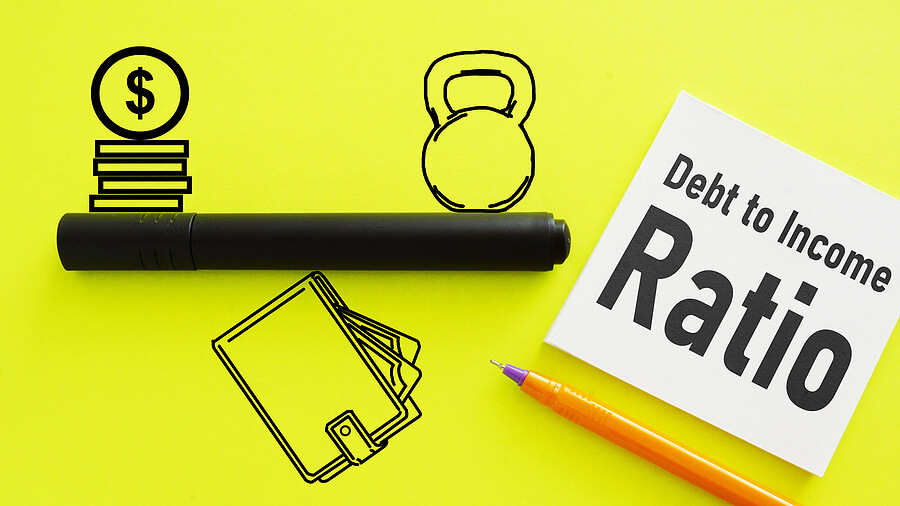Improve your chances of getting approved for a hard money loan by understanding what lenders qualify as an acceptable debt-to-income (DTI) ratio, and how they use it. If you’re considering an asset-based loan as a borrowing option for your next fix-and-flip project, you need to understand what metrics lenders use to assess your application. As a result, we’ve put together this article to help you create a stronger profile and avoid funding delays with an acceptable DTI ratio.

What is the Role of the Debt-to-Income Ratio in a Hard Money Loan?
Risk Assessment
Although most hard money lenders prioritize property value over the borrower’s income, asking about your financial history is still part of due process. As a result, your creditworthiness can play a secondary role in determining whether you secure a hard money loan. Think of it as the lenders using your DTI to get a clearer picture of your financial health and habits. Thus, a high DTI signals that you may be unable to repay your loans if the investment goes sideways. On the other hand, a low DTI indicates fewer financial responsibilities, which increases the likelihood of meeting your repayment deadlines without drama.
Term Negotiation
Determine what is a good debt-to-income ratio is by being transparent with your financial situation with lenders. If your DTI is low enough, it can work in your favor through better financial terms, such as lower interest rates or reduced fees. After all, the lower your DTI, the more financially trustworthy you seem, so lenders will be more open to offering better terms. In comparison, borrowers with a higher DTI are more likely to encounter tight-fisted lenders with stricter conditions since they present a higher risk.
Acceptable Debt-to-Income Ratio for a Hard Money Loan
Prepare to get pre-approved for a hard money loan by ensuring all required documentation is provided upon initial screening. While hard money lenders place greater value on your collateral, your DTI still counts for something during the assessment process. However, there’s often no strict maximum lenders use as a cutoff point, so it varies depending on who you ask. While some lenders have a strict threshold of 35%, others are more lenient by agreeing to work with borrowers with a DTI up to 50%. Moreover, a loan term can vary from one investor to another, even with the same lender, when they have different DTIs. Thus, it would be best to be transparent about your financial situation and inquire about the lenders’ policies when possible.
How to Improve Chances of Getting Approved for a Hard Money Loan?
Choose a High-Value Property
If you’re worried about having a high DTI, play to your strengths by working on what you can control. For example, the most important metric for assessing an application is the collateral. If you want to guarantee getting a yes from your hard money lender, choose a high-value property with a solid After Repair Value. The better the location, the more attractive your application is, and the better your chances of securing a loan.
Increase Your Down Payment
Another way you can improve your chances of approval is by increasing your down payment. Instead of banking on the lender to provide 90% of the funding for your house purchase and renovation, show them you’re committed by making a larger down payment. If you’ve got the funds, you can put down as much as 20% – 30% or even more on the property you’re eyeing. Such a move shows your hard money lender that you’re serious and believe in the viability of your project. Besides, a larger down payment also reduces their risk exposure because it means they don’t have to commit as much capital. That can make your project a less expensive, yet attractive offer in a mountain load of applications.
Create a Clear Exit Strategy
Boost the hard money lender’s faith in your project by creating a clear exit strategy. It’s not enough to present a property with good collateral and put your money where your mouth is. All of that counts for little if the project has no realistic way of paying itself off. As a result, borrowers who can effectively demonstrate their plan to flip, sell off, or refinance their property are in a much better position. Thus, it would be in your best interest to go into as much detail as possible about your intentions for the property, highlighting relevant timelines and budgets that can convince the lender that the project is in good hands.
Conclusion
Increase your chances of getting an approval by maintaining an acceptable debt-to-income ratio for a hard money loan. Despite not being the primary factor for decision-making with hard money lenders, your DTI can still affect their financial risk assessment of your application. It even affects what type of terms you receive in the long run. Thus, it would be best to keep your DTI between 35% and 50% for the best odds. You can also improve your chances by presenting a high-value property or demonstrating you know what you’re doing with a clear exit strategy.


